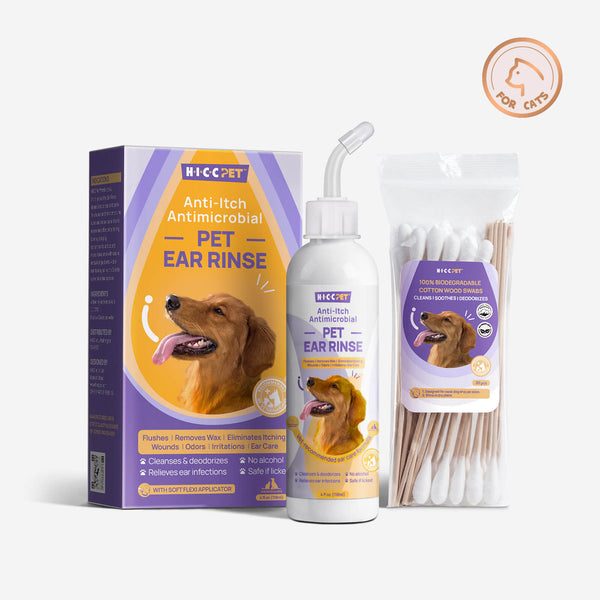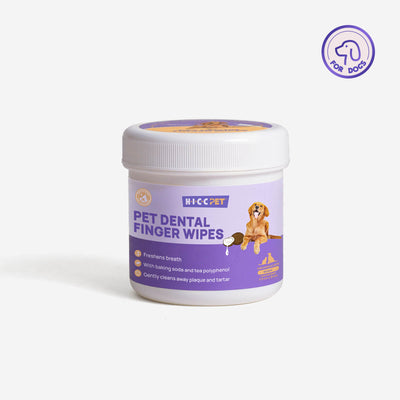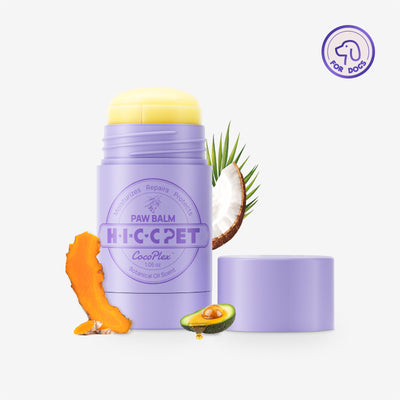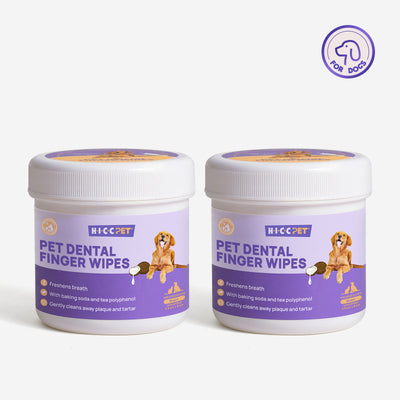Table of Contents
As cat owners, we know how important it is to keep our feline friends healthy and happy. One area that often goes overlooked is their ears. Cleaning your cat’s ears is an essential part of their grooming routine. Although cat ear infections are not as common as dog ear infections, you need to treat your cat’s ear infections as soon as possible to prevent the disease from spreading.
Today, HICC PET® discusses how to clean cat ears and walks you through everything you need to know about cleaning your cat’s ears, from understanding their anatomy to different cleaning methods and preventing ear problems.
Why It’s Important to Clean Cat Ears
Cleaning your cat’s ears is integral to their overall health and well-being. Your cat’s ears are a breeding ground for bacteria, yeast, and other harmful microorganisms. If left untreated, an outer ear infection can quickly spread to the middle inner ear causing severe pain and discomfort for your kitty.
Regular cat ear cleanings prevent the buildup of wax and debris, which can lead to a blockage in the ear canal. Wax blockage can cause hearing loss, balance issues, and even further ear infections. By keeping your cat’s ears clean, you can help prevent these problems.
Understanding Cat Ear Anatomy
Before we dive into the different methods of cleaning your cat’s ears, it’s essential to understand a little bit about their ear anatomy. Cats have a unique ear structure, with a vertical ear canal that makes it easy for debris and wax to get trapped inside.
The ear is made up of three parts:
- The outer ear: the part of the ear you can see. Made up of the pinna (the fleshy part) and the ear canal.
- The middle ear: the space behind the eardrum
- The inner ear: inside the ear canal. Responsible for balance and hearing.
Signs of Ear Problems in Cats
It’s essential to watch for any signs of ear problems in your cat. By identifying common symptoms and abnormal behavior, you can treat your cat’s ear infection before it worsens.
Some common signs of ear problems include:
- Scratching or rubbing at the ears.
- Head shaking or tilting.
- Discharge from the ears: yellow or brown.
- Redness or swelling around the ears.
- Unpleasant odor coming from the ears.
If you notice these signs, your cat may have an ear infection or underlying issues that need treatment.
Common Cat Ear Infections and How to Treat Them
Cats can develop a variety of ear infections. Here are a few to monitor in your feline:
-
Ear mites: These tiny parasites can cause intense itching, inflammation, and a dark, crumbly discharge in the ears.
-
Bacterial infections: Bacteria can infect the ear canal, causing a foul odor, discharge, and inflammation.
-
Yeast infections: Overgrowth of yeast in the ear can cause irritation, redness, and a dark, waxy discharge.
-
Allergies: Some cats may develop ear infections due to allergies to food, fleas, or environmental triggers.
- Foreign bodies: Occasionally, a foreign object, such as a grass seed, can become lodged in a cat’s ear canal and cause infection.
Treatment for your cat’s ear infection varies depending on the condition. If you suspect your cat is suffering from any of these illnesses, there are some at-home remedies you can try. Some solutions range from:
- Self-cleaning your cat’s ears at home.
- Applying prescription medications from the vet.
- Identifying any allergens causing the ear infection.
- Removing dirt, waxy discharge, or foreign objects from the ear
- Administering a vet-recommended cat ear-cleaning rinse.
For severe cases or ear infections that won’t go away no matter how hard you try, it’s time to call the vet. Untreated ear infections in cats can lead to permanent hearing loss.
Your vet can diagnose the type of infection and provide appropriate treatment, including medication and a regular cat ear cleaning schedule.

Do I Need to Use a Cat Ear Cleaner?
We suggest using a vet-approved cat ear-cleaning product for the best results. Ears are sensitive, and it’s better to be safe than sorry when dealing with this painful condition. Certain over-the-counter products have alcohols, additives, and harsh chemicals that may cause stinging and irritations inside the ear canal.
Pet-safe cat ear cleaners with organic ingredients are the way to go when looking for an effective solution. Search for cat ear cleaners with antimicrobial properties to heal and soothe your cat’s discomfort naturally.
How Often Should I Clean My Cat’s Ears?
The time you should spend cleaning your cat’s ears depends on a few factors, such as their breed, age, and overall health. Since cats’ ears are naturally self-cleaning, most owners do not need to clean them regularly.
Pay attention to any atypical behavior if your cat is prone to ear infections due to allergies, genetics, or lifestyle traits like getting soiled outdoors.
Here are some general guidelines to follow:
-
Observe your cat’s behavior: It may be unpleasant if the ears look red or if your cat frequently scratches or rubs its ears with a strong odor or discharge. If your cat’s ears look visibly dirty with wax in front the outside, it may be every day outside dirt collecting in the ear canal.
-
Consult with your vet: Your veterinarian can examine your cat’s ears and recommend a cleaning schedule based on their needs.
- Clean as needed: If your cat’s ears appear dirty or have a buildup of wax or debris, gently clean them with a soft cloth moistened in a vet-approved cat ear cleaner or use cotton balls to absorb any excess or leaking solution. If you use cotton swabs, avoid pushing them into the ear canal. Use the q-tips to wipe away debris on the ear’s outside.
Overall, it’s essential to be gentle when cleaning your cat’s ears and to never insert anything deep into the ear canal. If you’re unsure about how often to clean your cat’s ears or how to do so correctly, consult with your veterinarian.
How to Clean My Cat’s Ears at Home: Step-by-Step Guide
Cleaning cat ears at home is an easy process. Follow the instructions below for simple grooming tips and ear-cleaning routines to add to your cat’s regular hygiene.
Materials Needed:
- Natural Cat Ear Cleaning Solution
- Cotton Balls
- Cotton Swabs (Q-tips)
For the best cat ear wash, we recommend a natural product with clean ingredients for destroying bacteria and supplying gentle care. The best ear washes have a flexible nozzle for squeezing action to avoid wasting the ear cleaner.
- Don’t count on your cat sitting nicely. They are naturally skittish. Comfortably wrap your cat in a blanket or towel to prevent them from running away.
- Tilt your cat’s head to the side and gently insert the ear wash at the tip of the canal. Do not push in too deeply.
- The ear wash should squeeze out as a light stream or gentle drops. There should not be a rush of water pouring into the ear canal.
- As the ear wash cleanses the ear, keep your cat’s head slightly tilted, and use a washcloth or cotton swabs to clean up any leakage.
- If you are not comfortable with inserting a nozzle into the ear canal. Soak a cotton ball with the ear wash. Lightly dab and squeeze out the solution into the ear to your liking.
- Do not push the cotton ball deep into the ear. Allow the solution to leak inside the ear, or use the cotton ball to wipe any visible debris on the outside.
- Rub your cat’s ear’s base (bottom of the ear) and allow the solution to spread inside.
- Use the wet cotton ball or q-tip to gently wipe the inside of your cat’s ears, removing any noticeable wax or dirt.
- Your cat will naturally shake its head to remove any remaining liquid.
- Repeat the same procedure with the other ear.
How to Clean Cat Ears With Q-tips? Dos and Don’ts
Q-tips have long extensions and soft cotton tips for gentle cleaning without being too invasive. If you clean your cat’s ears with q-tips or cotton swabs, proceed cautiously. It’s essential to be as soft as possible, moving slowly with the cotton tip.
Never insert the q-tip directly or deep into the inner ear to avoid damaging the eardrum. For the best results, use the tip to gently wipe away wax on the outside of the ear or the very beginning of the ear canal.
To use q-tips, dip the end of the q-tip in warm water or cat ear cleaner and gently clean the outer part of the ear. Use a new q-tip for each ear to avoid spreading bacteria or debris.
Can You Clean Cat Ears With Water or Hydrogen Peroxide?
The short answer is no. Water contains no bacteria-eliminating ingredients to fight off infections or wax inside your cat’s ear. We also advise against hydrogen peroxide, which causes stinging, burning, and irritation and is not a pet-safe product. Some owners opt for apple cider vinegar as a natural remedy.
Apple cider vinegar is a very acidic solution that requires water dilution. Measuring how much apple cider vinegar you can safely drop into the ear may be challenging. We recommended using a certified product that will provide effective results instead. If you use apple cider vinegar, proceed with caution at your own risk.
How to Clean Cat Ear Mites at Home?
Ear mites are a common problem in cats and can cause itching, irritation, and inflammation in the ears. If your cat has ear mites, it is essential to treat them immediately to prevent further problems.
To clean ear mites from your cat’s ears, use a cat ear cleaner to flush out debris or wax buildup. Then, apply a topical ear mite treatment as directed by your vet. This may involve using a medicated ear drop or ointment.
Preventing Ear Problems in Cats
Prevention is guaranteed to keep your cat healthy long-term and avoid harmful infections. Some easy and effective ways to prevent cat ear problems include:
- Ear cleanings: Speak to your vet about how little or often you should clean your cat’s ears. The frequency will depend on your cat’s breed, age, and activities.
- Keep your cat’s ears dry: A wet and warm environment is a playground for bacteria. Ensure there isn’t any moisture collecting in your cat’s ears for a healthy kitty.
- Check the ears regularly for any signs of problems: Look for inflammation, itching, smelly ears, yellowish or abnormal discharge, or a wax buildup.
- Treat any underlying conditions: Your vet can inform you whether your cat has an ear infection or any underlying health condition. Once you identify the issue, you can try a vet-approved ear cleaning solution as a long-term preventative against cat ear infections.
By incorporating these habits into your cat’s routine, you can help prevent ear problems.
Are Cat Ear Infections Contagious to Dogs?
Cat ear infections do not typically affect dogs or humans unless your cat has a parasitic infection like ear mites. Ear mites are contagious to other cats, so if you own multiple cats, it’s essential to keep them separated or use a preventative solution to keep the ear mites away.
Is Cat Ear Cleaner Useful for Dogs?
Some products are strictly for use for certain breeds only. Look no further than HICC PET™ for organic ear care solutions for cats and dogs. Our cat ear wash is safe for all furry animals in your household.
Stop Cat Ear Infections With a HICC PET™ Natural Pet Ear Rinse
We love seeing our cats live their best lives in the healthiest manner possible. At HICC PET™, we develop natural skin care products that soothe, treat, and remove harmful bacteria from your cats and dogs. We know how important it is to have convenient care solutions at an affordable price.
The best part is that our solutions heal skin infections, ear irritations, and hot spots, and more for more cuddles and less stress. The pet ear rinse is an organic disinfectant that gently removes wax, odors, and other harmful germs that may cause painful ear infections. Use it for daily hygiene or to treat ear mites, yeast infections, ringworm, or wax buildup before it starts. Subscribe to our pet tribe for helpful pet care tips and natural pet wellness products.
Please note that the information provided in this article is for educational and informational purposes only. We are not veterinarians, and the content shared here should not be considered professional veterinary advice.
If you have any questions regarding copyrights or the use of materials in this article, please contact us for clarification.







Thanks for your interaction and support.